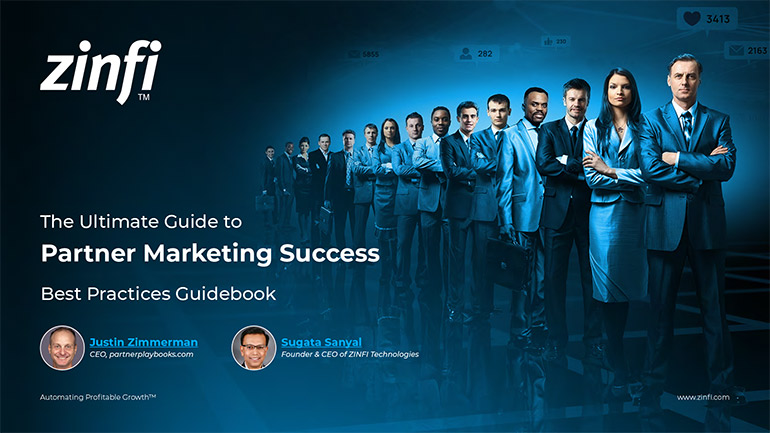Best Practices Articles

To Ensure Marketing ROI, Why Clients Must Track Agency Costs
A few days ago I read a post on LinkedIn by Tim Williams (a LinkedIn Influencer) entitled “Your Costs Are None of Your Client's Business”. Williams discusses why an agency should focus on output (e.g., marketing ROI) vs. input (hours spent, etc.). We fully agree with Tim and would like to add that the discussion related to marketing ROI needs to shift towards what the client is truly looking for vs. explaining why the client is asking for a vendor cost detail.
We at ZINFI sincerely believe that focus for any marketing agency should be to provide its customers with tangible marketing return on investment (marketing ROI). This can only happen if an agency innovates continuously and maintains a sharp focus on marketing ROI. This doesn’t happen in most agencies today, however, and as a result the customers (buyers) tend to focus on cost-based analysis vs. return or outcome-based engagement. Here is a summary of the core challenges that the marketing agencies face today:
- It is the customers’ job and need to get the best value (highest marketing ROI) in the marketplace in one way or the other, so they have the right to ask for bottoms-up cost analysis if the pricing rationalization is not substantiated through results. You don’t need to ask for the cost of an Apple iPhone, because you can compare it to a Samsung Galaxy and know whether you are getting fair value or not. You cannot do that in case of marketing or sales services with most agencies today, until and unless you break it down to the component level.
- Most agencies lack (or avoid) performance accountability to the client. Input metrics like impression are not enough. Effort needs to be directly linked and measured to output (i.e., marketing ROI, sales, etc.), even if it is a traditional branding campaign. Branding is nothing but price premium attained and inbound lead flow for the future. Until agencies are able to shift the conversation to output (marketing ROI), clients will continue to ask for bottom-up cost analysis.
- However, many agencies play this game – and pretend to be the victim of the circumstances instead of owning the very fact that they are the ones who are causing it. Most agencies get higher margins by adding more hours to a project than what it needs. This is hard for clients to track. This is unethical, but happens a lot.
- When you are selling commodity services, which most agencies do, the buyer (client) has the right to get the cheapest services available. They only way to ask for a premium is to provide superior value. That means better marketing ROI, and that is only possible when an agency focuses on true innovation versus trying to figure out how to pad billable hours to reach revenue and profitability targets.
- Most big agencies operate on the principle of scale (and rolling up smaller agencies into a bigger cost structure) instead of value innovation. Acquiring another agency to eliminate competition or increase reach is not innovation. Adding digital competency to the portfolio to bridge a gap from a competitor is not innovation; it’s merely catching up and staying in the business. The true measure of innovation comes from complete transparency and superior marketing ROI.
These core challenges go a long way toward explaining why agencies are undergoing much closer scrutiny from their clients, who are tired of the “same old same old” and looking for true marketing ROI. And this is why the agency business model is also ready for complete disruption. Margins are disappearing in most agencies because the old model no longer works. Service is a product and, like all analog products, services delivered by agencies now require radical rethinking in the digital age. Until that happens, customers have every right to ask every question about agency financials and understand what the agency is truly bringing to the table when it comes to marketing ROI.
To win in the new digital age, a marketing agency needs a different approach. The business needs to be built bottom- up and top-down with single-minded focus towards delivering marketing ROI to client. When that happens an agency, like ZINFI, should have zero issues in walking clients through their financials. But to have confidence in that process, the agency needs to make sure their cost structure is the lowest in the industry by leveraging innovation end to end – globally. The client is buying a solution (marketing ROI); just providing services or software support is not enough.
Now to substantiate everything that I have written above, I want to use our business model as a true example. In order to digitize service delivery and drive up marketing ROI in this digital age, we have built a state-of-the-art industry-leading channel marketing automation platform, what we call Unified Partner Management. We provide our software at an incredibly affordable price point in the industry because we know our customers need to see instant value – not a break-even promise five years out. Our software and services pricing is value-based, not cost-based. And, as a result of this price structure, we are growing quarter after quarter profitably. We have not raised any money from external investors, and have been able to grow our relationships with our Fortune 1000 clients year after year by doing more for less every year for these clients. This has been our vision from day one, and we have been incredibly fortunate to have customers that demand superior marketing ROI every quarter, and we continually strive to meet that challenge.
Now, speaking of competitiveness in the marketplace, when it comes to services, we also charge significantly less for our services than our global competitors to provide better marketing ROI. How do we do that? Simple: We use our own software to automate our workflow end to end. We know by the minute who worked on what, and what activity we can automate further to take cost out, improve service quality and enhance marketing ROI. This is what we call Six Sigma Lean Marketing; a new way of marketing that provides tangible value (marketing ROI). We automate what we do for our clients, but most importantly we constantly innovate in the services we provide our clients. This integrated approach, much like the Apple ecosystem that Williams talked about in his LinkedIn post, gives us complete control over what we deliver to our clients, the power to be accountable for results (which most agencies cannot do today), and the ownership to eliminate non-value-added steps and costs to increase marketing ROI.
So, based on our own experience, we wholeheartedly agree with Williams when he says that an agency must shift the conversation to output and show ROI by innovating end to end and owning the outcome. Until that happens, for most agencies their costs are ABSOLUTELY the client's business!
Best Practices Guidebook
 The Ultimate Guide to Partner Marketing Success Best Practices
The Ultimate Guide to Partner Marketing Success Best PracticesDownload Guide
 How to Start and Scale Partner Ecosystems Best Practices
How to Start and Scale Partner Ecosystems Best PracticesDownload Guide
 The Evolution of PartnerOps: Past, Present & Future Best Practices
The Evolution of PartnerOps: Past, Present & Future Best PracticesDownload Guide
 Mastering Channel Sales: Strategies, Best Practices, and Growth Tactics for 2025
Mastering Channel Sales: Strategies, Best Practices, and Growth Tactics for 2025Download Guide
 Winning with Partner Advisory Councils: Best Practices for Partner Engagement & Growth
Winning with Partner Advisory Councils: Best Practices for Partner Engagement & GrowthDownload Guide
 The Future of Partner Ecosystems Best Practices
The Future of Partner Ecosystems Best PracticesDownload Guide
 The AI Revolution: How Technology and Talent are Shaping the Future
The AI Revolution: How Technology and Talent are Shaping the FutureDownload Guide
 Top 105 Partner Management Metrics that Matter Best Practices
Top 105 Partner Management Metrics that Matter Best PracticesDownload Guide
 Mastering PRM Integration Best Practices
Mastering PRM Integration Best PracticesDownload Guide
 Building a Sales Partner Portal with Salesforce Best Practices
Building a Sales Partner Portal with Salesforce Best PracticesDownload Guide
 Building and Managing Partner Ecosystems Best Practices
Building and Managing Partner Ecosystems Best PracticesDownload Guide
 Mastering Co-Marketing and Co-Selling Best Practices
Mastering Co-Marketing and Co-Selling Best PracticesDownload Guide
 Transforming Partner Ecosystems Best Practices
Transforming Partner Ecosystems Best PracticesDownload Guide
 Mastering Partner Ecosystems Best Practices
Mastering Partner Ecosystems Best PracticesDownload Guide
 Mastering Partner Onboarding Best Practices
Mastering Partner Onboarding Best PracticesDownload Guide
 Partner Ecosystem Management Best Practices
Partner Ecosystem Management Best PracticesDownload Guide
 B2B Marketing in the Age of Intelligence Best Practices
B2B Marketing in the Age of Intelligence Best PracticesDownload Guide
 Multi-Partner Co-Selling Best Practices
Multi-Partner Co-Selling Best PracticesDownload Guide







